Aeollanthus rydingianus
Aeollanthus rydingianus Van Jaarsv. & A.E.van Wyk
Family: Lamiaceae
Common names: Omavanda rock-sage (Eng.); omavanda-klipsalie (Afr.)
Introduction
A very aromatic, fast-growing, branched, semi-succulent shrublet, with sticky, green leaves, bearing mauve, 2-lipped flowers in winter and spring. It is only known from two widely separated locations, the one a rocky ledge of a sheer, south-facing cliff on a solitary mountain in northern Namibia and the other on a cliff along the southwestern escarpment margin in southern Angola. Easily grown from cuttings or seed and best for warm, subtropical gardens with a winter-dry climate.
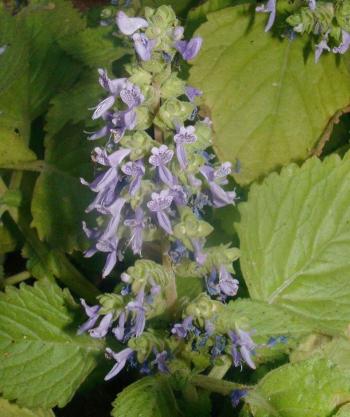
Fig. 1. Aeollanthus rydingianus in flower in its habitat, in winter, on the Omavanda Cave.
Description
Description
Aeollanthus rydingianus plants are softly semi-succulent, branched, ascending, strongly aromatic subshrubs, up to 600 mm tall. Most of its surface is covered with glandular hairs. Its roots are fibrous. The branches are terete (circular in cross section), the main branch is up to 20 mm in diameter, with brown, peeling bark at the base. The younger branches are 7–8 mm in diameter, green and sparsely covered with transparent glandular hairs. The nodes are about 20–30 mm long, the internodes often covered in short, leafy branchlets in the axils, each with 3 pairs of leaves overtopped by normal leaves. Leaves grow in opposite pairs (decussate); those on axillary branches 20–40 × 15–20 mm (occasionally much shorter), very shortly petiolate; normal leaves spreading, long-petiolate, 70–140(–200) × 40–80(–100) mm, becoming drooping, often exposing suppressed, axillary branches; lamina broadly ovate to broadly triangular-ovate, fleshy, tomentose, slightly viscous owing to glandular translucent hairs; adaxial surface channelled, slightly rugose, densely covered in soft translucent glandular hairs 0.5–2.0 mm long, abaxial surface reticulate; veins prominent, densely beset with glandular hairs, elsewhere hairy; margin dentate with 7–10 pairs of teeth, 5–7 mm long and each with a secondary tooth at base, decurrent on petiole; apex acute to subacute; base cuneate to attenuate; petiole sub-terete, 15–40 mm long, 5 mm in diameter.
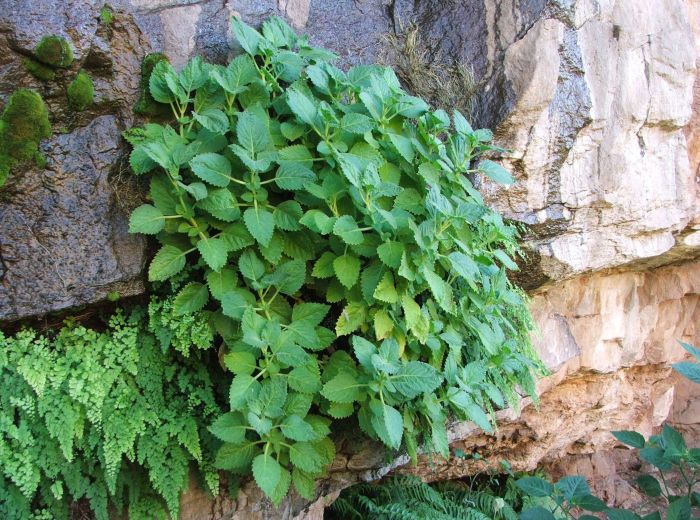
Fig. 2. Aeollanthus rydingianus, in habitat on the cliff at Omavanda, in summer.
Inflorescence a terminal, lax, pyramid-shaped panicle, 100–125(–200) mm high, 60 mm wide at base; spikes becoming gradually smaller towards the tip, those of the main axis with opposite flowers, other spikes bearing 1 or 2 flowers at each node; basal spikes up to 30 mm long, shortly stalked, each with a pair of short side branches at the base; peduncle 4 mm in diameter at base, gradually becoming thinner distally; bracts concave, broadly ovate, densely imbricate, 5.5–8.0 × 4.0–5.5 mm, surface with 3 obscure veins, covered with short glandular hairs, apex acute, sterile bracts slightly smaller. Calyx bell-shaped, green, 1.75–2.5 mm long, basal part circular, 1 mm in diameter, widening towards the apex; upper lip 3-lobed; lower lip infolded. Corolla white (Angola) or mauve (Namibia), 12–15 mm long, 2-lipped; tube 1 mm in diameter at base, widening to 3.5 mm at throat; upper lip erect, 4-lobed, 8 mm high, bearing dark purple dots; lower lip 8–9 mm long, horizontal, boat-shaped (cymbiform), blunt at the end. Stamens 8–9 mm long, mauve; anthers 1 mm in diameter; pollen yellow. Style (9–)15–16 mm long, lengthening to up to (11–)17–18 mm when ripe. Nutlets 1.3 × 1 mm, smooth, black. Flowering time is in winter and spring.

Fig. 3. The flowers of Aeollanthus rydingianus, growing in the Conservatory, Kirstenbosch National Botanical Garden.
Conservation Status
Status
Although very rare in Namibia, and plants grow in an isolated location in a uniquely and superficially moistened environment, it is locally abundant at this site. It is also known from the Huila Plateau in southwestern Angola and is not uncommon at this location. Since its naming, it has been well-established in cultivation (ex situ conservation).

Fig. 4. The habitat of Aeollanthus rydingianus, the broad cliff ledge at Omavanda (Baynes Mountains, Kaokoveld, northern Namibia).
Distribution and habitat
Distribution description
Known only from the Otjihipa Mountains in northwestern Namibia and from 2 records on top of the southwestern, inland escarpment margin in the Huila Province near Lubango, southwestern Angola. The region in-between these 2 sites (about 250 km) is desolate, without sufficient infrastructure and is not well documented. There is, thus, a great possibility that the distribution is continuous and that plants should be found at sites in-between.

Fig. 5. The Omavanda Cave Kaokoveld, northern Namibia, habitat of Aeollanthus rydingianus, in winter.
At Omavanda, northern Kaokoveld, south of the Kunene River, plants grows on a broad, south-facing, sandstone (Damara Sequence) cliff ledge. Moisture constantly dripping down the cliff face ensures a constant supply of moisture all year round, both for plants and the Rosy-faced Lovebirds (Agapornis roseicollis), which breed in the cliffs above. Aeollanthus rydingianus forms dense, soft shrubs and grows together with various plant species. These include some ferns (Adiantum sp. and others), brittlewood (Nuxia congesta), Angolan cabbage tree (Cussonia angolensis), tobacco (Nicotiana tabacum), yellow-bark wild fig (Ficus bubu), Namib stinging nettle (Obetia carruthersiana), Namib coleus (Coleus dinteri), Manuleopsis dinteri, broom cluster fig (Ficus sur), hairy-leafed rock fig (F. glumosa), Namib rock fig (F. ilicina), iboza (Tetradenia riparia), klipdagga (Leonotis ocymifolia), and the pigeon wood (Trema orientalis). About a few hundred metres along the ledge, the annual Aeollanthus elscholzioides was also encountered, growing below a Ficus sur. Aeollanthus elscholzioides is related to A. rydingianus and this is the first record of A. elscholzioides for Namibia. The Omavanda cliff-hanger aloe (Aloe omavandae) also grows in the habitat but on the sheer cliffs above, sharing its habitat with Cotyledon orbiculata and Sarcostemma viminale. Rainfall is in summer (thunder showers) and estimated about 250–350 mm per annum (Mendelsohn et al. 2002). Summers are hot, with mild and frost free winters. Plants grow at an altitude of about 1 800 m.
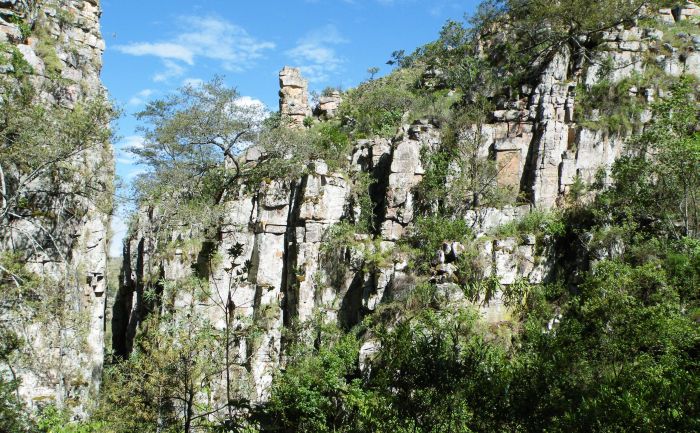
Fig. 6. The cliff face habitat of Aeollanthus rydingianus at Zootec on the Huila plateau in southwestern Angola.
At Zootec, along the western Huila Plateau margin in Angola, Aeollanthus rydingianus was collected on the upper sandstone cliffs at an altitude of 1 800–2 000 m above sea level. Associated plants in this habitat include Aloe mendesii, Podocarpus huilensis, Olinia sp., Syzygium guineense and a species of Faurea and Ochna. Aeollanthus rydingianus also shares this habitat with the related annual A. elscholzioides.
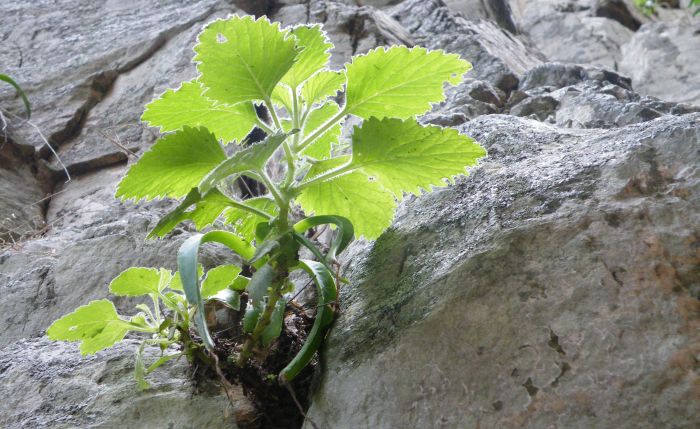
Fig. 7. Aeollanthus rydingianus sharing its habitat with Aloe mendesii on a cliff face at Zootec in southwestern Angola, in the summer of 2009.
Derivation of name and historical aspects
History
Aeollanthus rydingianus was named in 2005, in Bothalia, by Braam van Wyk and the author (Van Jaarsveld & Van Wyk 2005) from plants collected at Omavanda Cave in the Baynes Mountains, Kaokoveld, northern Namibia, in July 2002. It commemorates Dr Per Olof Ryding, Swedish botanist from the University of Copenhagen, Denmark, who revised the genus Aeollanthus in 1986. Aeollanthus rydingianus was found by the author and his team on an expedition to the Baynes Mountains in Kaokoveld. In fact they were on their way to investigate a possible new aloe growing on sandstone cliffs in the region (later named Aloe omavandae). As they approached the southern end of the mountain range, at Omavanda, a faint footpath was discovered (a Himba track) which led them to a cave on the upper sandstone massif. This part remains shady because of the southern aspect below a steep cliff. Moisture drips from the cliff which provides a drinking spot for the Rosy-faced Lovebirds and plants growing on a ledge below. It was on this ledge that a herbaceous perennial with mauve flowers was spotted. The plant was immediately identified as an Aeollanthus and it was later revealed that it was also collected earlier on the Huila Plateau in southwestern Angola by the botanist Joaquim Taxeira (1917–1969) and others in 1968 (earliest collection). This was later confirmed when the author in 2009 collected it at Zootec on the Huila Escarpment on an expedition to southwest Angola arranged by Professor Brian Huntley, executive director of the National Botanical Institute (now the South African National Biodiversity Institute).
Aeollanthus rydingianus is one of 45 known Aeollanthus species. Most are from tropical Africa. For more information on its generic name and background about Aeollanthus in Namibia and South Africa, see the article on A. haumannii in this series on the PlantZAfrica website.
Aeollanthus rydingianus belongs to section Rotundobasis and with only 3 other members in Namibia and South Africa: A. elscholzioides, A. parvifolius and A. rehmannii. It is most closely related to the annual A. elscholzii, a smaller plant. It cannot be confused with any other southern African species. Its highly aromatic nature is unique and its leaves are the largest among other species of Aeollanthus in the region.

Fig. 8. The related Aeollanthus elsholzioides growing at Omavanda in summer.
Ecology
Ecology
The flowers are pollinated by insects. The highly aromatic, sticky leaves protect the plants from herbivores, such as rock rabbits (Procavia spp.). The sticky epidermis also discourages aphids and other small insects.
The plant is a cliff-squatter, the semi-succulent nature of the leaves enables plants to survive periods of drought.
The small black nutlets are released once the calyx breaks free at the abscission layer and are dispersed locally. The plants are well adapted to their habitat, releasing the nutlets close to the mother plant and remaining in the protective cliff-face environment.
Vegetative propagules produced at the tips of the flowering spikes of Aeollanthus rydingianus ensure vegetative dispersal. After the flowers, fruits and bracts have been shed, the main axis remains alive and small vegetative shoots appear. These are shed in the autumn and will root below the mother plant or may be blown by wind onto another crevice. This vegetative propagation backup has been found in many cliff-dwelling succulents and bulbs.
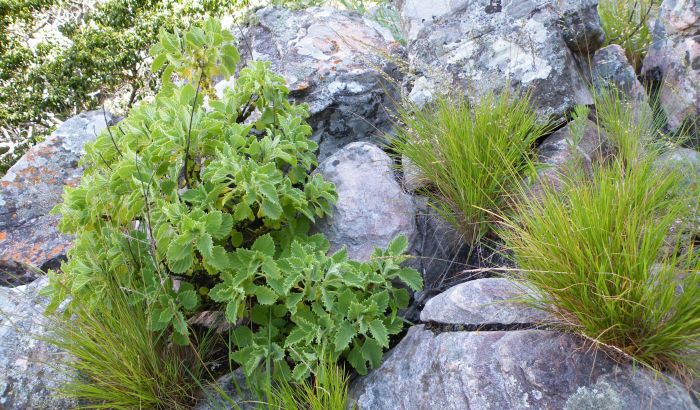
Fig. 9. A mature plant of Aeollanthus rydingianus growing at Zootec in January 2009.
Uses
Use
It is not known whether the plants are used medicinally.

Fig. 10. Aeollanthus rydingianus growing among maidenhair fern (Adiantum) on a moist cliff ledge in summer. The plants thrive because of a constant seepage of moisture.
Growing Aeollanthus rydingianus
Grow
Aeollanthus rydingianus is easily cultivated and can be multiplied by both seed or vegetatively by cuttings or propagules on the flowering branch. It grows well in Mediterranean climate, bushveld (savanna) and subtropical gardens, where frost is absent or very light. It can also be grown in containers and hanging baskets and taken indoors when becoming too cold. The plants do better in a dappled shady area or where it receives bright light, but not full sun, such as on the south side of buildings (southern hemisphere). Because of its very aromatic, sticky nature it is pest free. Best planted in a rockery, and the plants are not shy to flower. Plants established at Babylonstoren Farm and at a Stellenbosch garden, in spite of winter rainfall, have also grown very well. Plant in a sandy, well-drained soil. Feed with an organic fertiliser such as well broken down compost or liquid fertiliser. Once established, plants are not shy to flower. Plants are fast growing and when becoming untidy, can be pruned back or restarted from new slips.

Fig. 11. Aeollanthus rydingianus in flower in spring, growing in a garden in Stellenbosch (Western Cape, South Africa).
Sow seed in spring or summer in a seed tray, in a well-drained medium (2 parts sand or gravel, 1 part garden loam and 1 part leaf mold or compost). Cover with a thin layer of sand or gravel. Keep moist in a warm position, ideally in dappled shade. Germination is within 3 weeks. Transplant young seedlings when large enough to handle, which is at least a year or two after sowing. Cuttings are best taken during the warmer months. The length can be 5–10 cm long. Remove the lower leaves and place the lower third into a medium such as sand and keep moist. Rooting is rapid (about 2 to 4 weeks) and the young rooted cuttings can be planted into individual containers.
References
- Clarke, H. & Charters, M. 2016. The illustrated dictionary of southern African plant names. Flora & Fauna Publications Trust, Jacana, Johannesburg.
- Codd, L.E. 1985. Lamiaceae. Flora of southern Africa, Vol. 28, 4. Botanical Research Institute, Department of Agriculture and Water Supply, Pretoria.
- Mendelsohn, J., Jarvis, A., Roberts, C. & Robertson, T. 2002. Atlas of Namibia. David Philip, Cape Town.
- Ryding, O. 1986. The genus Aeollanthus s. lat. (Labiatae). Acta Universitatis Upsaliensis. Symbolae Botanicae Upsaliensies 26: 1.
- Van Jaarsveld, E.J. 2010. Water wise gardening. Struik, Cape Town.
- Van Jaarsveld, E.J. & Van Wyk, A.E. 2005. Notes on African Plants, Lamiaceae, Aeollanthus rydingianus, a new species from northern Namibia and southern Angola. Bothalia 35: 2: 157–160.
- Van Jaarsveld, E.J. & Van Wyk, A.E. 2006. Aeollanthus haumannii (Lamiaceae), a new species from the Kaokoveld, Namibia. Aloe 43,4: 72–75.
Credits
Ernst van Jaarsveld
Kirstenbosch National Botanical Garden (Retired 2015)
Babylonstoren Farm
Extraordinary senior lecturer and researcher,
Department of Biodiversity and Conservation, University of the Western Cape
November 2020
Plant Attributes:
Plant Type: Perennial, Succulent
SA Distribution:
Soil type: Sandy, Loam
Flowering season: Spring, Autumn, Winter
PH: Acid, Neutral
Flower colour: Mauve/Lilac
Aspect: Full Sun, Morning Sun (Semi Shade), Afternoon Sun (Semi Shade)
Gardening skill: Easy
Special Features:
Horticultural zones









Rate this article
Article well written and informative
Rate this plant
Is this an interesting plant?
Login to add your Comment
Back to topNot registered yet? Click here to register.